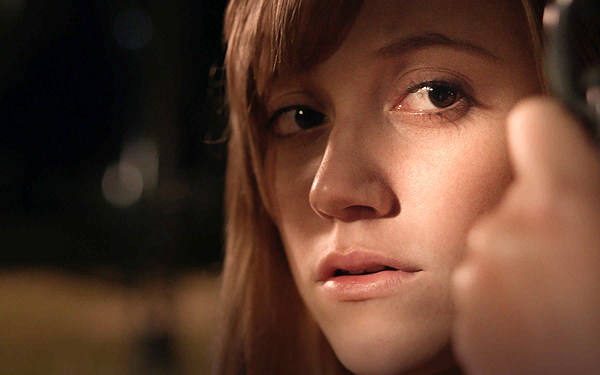By Shanee Edwards.

David Robert Mitchell
David Robert Mitchell found critical success with his first feature film, The Myth of the American Sleepover in 2010, which won the Special Jury Award at the SXSW Film Festival. Now, the Michigan-native writer/director tries his hand at horror with his dark and hypnotic new film, It Follows.
Mitchell claims the basic premise of It Follows, being stalked by something monstrous or otherworldly, came from a childhood nightmare. “I got to thinking about trying to make a horror film. I added the sexual element and decided I should just put it down on paper.” He wrote the draft in a mere ten days.
It Follows stars the super-emotive and lovely Maika Monroe as Jay, a 19-year-old bored suburbanite, looking for attention from a seemingly average dude named Greg, played by Daniel Zovotto. Jay and Greg have sex in the back of Greg’s car and Jay catches an STD, but it’s not what you think. What she catches is not a disease, but actually a sexually transmitted demon. Her life soon becomes a living hell. In this horror world, the only way to get rid of the monster following her is to pass it to another young man by having sex with him.

Maika Monroe as Jay Height in It Follows
But the film isn’t about sex-shaming. Mitchell said he enjoys playing with traditional horror tropes and while having sex is Jay’s downfall, it may be her salvation as well.
“I tend to play with clichés. I often embrace things that are sometimes overused and change them in very small ways. For instance, the idea that the characters are opening themselves up to some danger by having sex – that’s something we see in a lot of horror movies,” he said. But Mitchell suggests that sex is also a way the characters can be free. Or at least temporarily escape the evil that is trailing them.
“It’s not about condemning, or making a puritanical statement. It’s about doing something more than that.” Sex plays an important role in the story, but it’s a fresh take on an old, overused genre rule.
We asked Mitchell about his own personal recipe for creating horror and building suspense. Heavily influenced by Alfred Hitchcock, he said a lot of the movie is about the anxiety that builds in moments where the characters are simply waiting. “Some of it is about putting emphasis on a scene that wouldn’t normally be a part of a horror film, things that might be a quick transition – I’m actually focusing on those things. It’s about waiting. It’s about the conversations that happen in between the terrible things that are coming, or between the attacks. Those sort of quiet spaces, those quiet moments.”

Maika Monroe as Jay Height in It Follows
Mitchell said he was conscious of using metaphor while he was writing the script, but didn’t pick one thing to be the single meaning of the film. “I’m hesitant to say, ‘the film means this’. I like the idea that the viewer’s interpretation is just as valid as mine.”
We asked Mitchell about the film’s heroine, Jay, and her transformative journey. He said what sets her apart from other horror protagonists is that she cares deeply for those around her. “She’s not a selfish person, she cares about the people in her life, about others and I think it’s through that she finds some strength. There is definite growth there and change, and she gains a new understanding of her world and her place in it.”
It Follows is a quiet film, with very little dialogue and even less exposition, something that seems innate in Mitchell, given that he’s also a director. “I like to express things visually as much as possible. I see it when I’m writing the script. For me, the script is very much a guide or a blueprint so I can recall that idea I had at the computer so when I get on set, and I’m stressed about getting my shots, it’s a short hand for me.”

Maika Monroe as Jay Height in It Follows
But he said that cutting out the exposition can be risky. “It’s tricky at the writing stage. You have to trust me, I mean, some of it is going to come out through performances, casting choices, through the visual language of the film. Everything is going to work together, that’s the goal. It’s about a tone or a feeling that can be hinted at on the page, but it’s also about setting it up to accomplish those things. There’s a tendency for people to want things explained on the page in a way that can result in a weaker film. It may be an easier read, but it’s not necessarily what you want as a starting point for your movie.”
